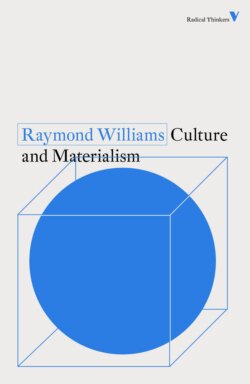Читать книгу Culture and Materialism - Raymond Williams - Страница 24
На сайте Литреса книга снята с продажи.
Critical Theory as Consumption
ОглавлениеWhat then are the implications of this general analysis for the analysis of particular works of art? This is the question towards which most discussion of cultural theory seems to be directed: the discovery of a method, perhaps even a methodology, through which particular works of art can be understood and described. I would not myself agree that this is the central use of cultural theory, but let us for a moment consider it. What seems to me very striking is that nearly all forms of contemporary critical theory are theories of consumption. That is to say, they are concerned with understanding an object in such a way that it can profitably or correctly be consumed. The earliest stage of consumption theory was the theory of ‘taste’, where the link between the practice and the theory was direct in the metaphor. From taste there came the more elevated notion of ‘sensibility’, in which it was the consumption by sensibility of elevated or insightful works that was held to be the essential practice of reading, and critical activity was then a function of this sensibility. There were then more developed theories, in the 1920s with I.A. Richards, and later in New Criticism, in which the effects of consumption were studied directly. The language of the work of art as object then became more overt. ‘What effect does this work (“the poem” as it was ordinarily described) have on me?’ Or, ‘what impact does it have on me?’, as it was later to be put in a much wider area of communication studies. Naturally enough, the notion of the work of art as object, as text, as an isolated artefact, became central in all these later consumption theories. It was not only that the practices of production were then overlooked, though this fused with the notion that most important literature anyway was from the past. The real social conditions of production were in any case neglected because they were believed to be at best secondary. The true relationship was seen always as between the taste, the sensibility or the training of the reader and this isolated work, this object ‘as in itself it really is’, as most people came to put it. But the notion of the work of art as object had a further large theoretical effect. If you ask questions about the work of art seen as object, they may include questions about the components of its production. Now, as it happened, there was a use of the formula of base and superstructure which was precisely in line with this. The components of a work of art were the real activities of the base, and you could study the object to discover these components. Sometimes you even studied the components and then projected the object. But in any case the relationship that was looked for was one between an object and its components. But this was not only true of Marxist suppositions of a base and a superstructure. It was true also of various kinds of psychological theory, whether in the form of archetypes, or the images of the collective unconscious, or the myths and symbols which were seen as the components of particular works of art. Or again there was biography, or psycho-biography and its like, where the components were in the man’s life and the work of art was an object in which components of this kind were discovered. Even in some of the more rigorous forms of New Criticism and of structuralist criticism, this essential procedure of regarding the work as an object which has to be reduced to its components, even if later it may be reconstituted, came to persist.
